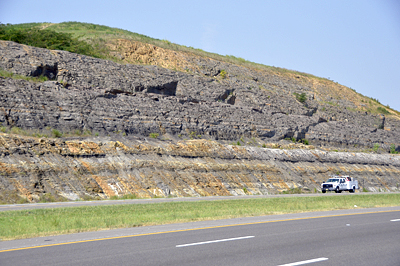
In many parts of the world, the rocks are covered by grass, trees, farmland, buildings, parking lots, etc. They can make if very difficult to find out what is under the surface. In those areas, road cuts are a great way to see the rocks that are normally hidden. They can reveal different layers of rock, faults, igneous intrusions, and many other geologic structures that are normally difficult to see.
Before you head for the nearest highway, there are some things you need to know:
- Be sure that it is legal for you to collect at the site. This varies from state to state, and city to city, so check your local laws. Never collect specimens in state or national parks.
- Be sure that it is save to collect. Make sure that you are not in any danger of being hit by a car, and be careful of loose stones, steep inclines, and falling rocks.
- Be careful of wildlife. The rocks in a road cut make good homes for a variety of spiders, snakes, scorpions, wasps, ants, ticks, and chiggers. Be aware of plants with spines and thorns, as well as irritating plants, such as poison ivy.
- Do not dig or excavate on road cuts. The Highway Department works hard to control erosion, and to make the rocks safe for passing cars. Don't make their job any harder.
Even if you can't collect specimens, you can still use road cuts to explore the local geology. Digital cameras make it incredibly easy to photograph the road cuts in your area to get a better idea about the structure of the rocks. As you take the photos, plot each road cut on a map. You will soon have a very good idea of the geology that is under the surface.
